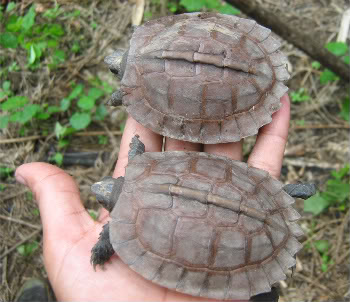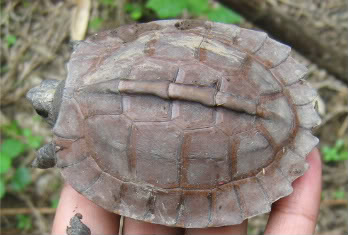Scientists have stumbled on the Arakan forest turtle for the first time in the wild, according to a report by the Wildlife Conservation Society (WCS). One of the world’s rarest turtles, the Arakan forest turtle was thought to be extinct for 86 years, before being discovered in an Asian food market in 1994. It has never before been observed in the wild by scientists.
A team with WCS found five of the Critically Endangered turtles in a wildlife sanctuary in Myanmar (also known as Burma). The rarely-visited sanctuary was originally created to protect Asian elephants.
The foot-long turtle is near extinction. Its fate has been similar to many other turtle species across Asia, which have been devastated by relentless hunting for their meat and purported medicinal qualities.
 Photos show two juvenile Arakan forest turtles observed in the wild in Myanmar by a team of scientists led by the Wildlife Conservation Society. Photo by: Steven Platt. |
“Throughout Asia, turtles are being wiped out by poachers for the illegal wildlife trade,” said Colin Poole, WCS Director of Asia programs. “We are delighted and astonished that this extremely rare species is alive and well in Myanmar. Now we must do what we can to protect the remaining population.”
Now that a population has been confirmed in the reserve, WCS recommends training local area staff and graduate students to collect additional data on the little-known species, while establishing permanent guards at every road going in and out of the reserve to combat poaching.
The Arakan forest turtle isn’t the only rare turtle in the reserve. Researchers also found Asian leaf turtles Cyclemys dentate, classified as Near Threatened and yellow tortoises (also known as elongated tortoises) Indotestudo elongate which are considered Endangered.
 Detail of one of the turtle’s found.In 1908 a British Army officer collected the last Arakam turtle until 1994 when a dead specimen was found in an Asian food market. Photo by: Steven Platt. |
Labeled one of the world’s 25 most threatened turtles, the Arakan forest turtle has proven difficult to breed in captivity, although Zoo Atlanta has had the most success, producing five offspring since 2005.
Locally, the species is known as “Pyant Cheezar”, which means “turtle that eats rhino feces”. Sumatran rhinos once roamed the area, but hunting caused the species to go locally-extinct fifty years ago.
Related articles
Despite legal protection, Indian turtles are poached for restaurant trade
(08/10/2009) Despite being accorded the highest level of protection under Indian law, soft shell turtles are regularly trafficked in Kerala for the restaurant trade, report researchers writing in in the journal Tropical Conservation Science.
World’s rarest tortoises stolen

(06/08/2009) Four of the world’s rarest tortoises have been stolen from a captive breeding program in Madagascar. The critically endangered animals were part of a group of 44 due for release by the Durrell Wildlife Conservation Trust and were being held in pre-release enclosures at a secret location. The Trust fears the stolen ploughshare tortoises are destined for Europe, USA or Asia where collectors will pay thousands of dollars for individuals due to the rarity of the species. It is estimated that only 500 adults remain in the wild and they are only found in Baly Bay national park, where the tortoises were taken from. After extensive investigations in the area arrests have been made but the tortoises are yet to be recovered.
Will the illegal trade of the critically endangered Philippine forest turtle lead to its extinction?

(05/04/2009) Endangered Species International (ESI) conducted ongoing monitoring at markets known to sell pets and wild animals in Manila, Philippines, to monitor the status of the trade of one of the most endangered turtle in the world: the Philippine forest turtle Siebenrockiella (Panayenemys) leytensis,. The critically endangered Philippine forest turtle is endemic to the Philippines, occurring only on one major island, Palawan, and its small satellite island, Dumaran.







